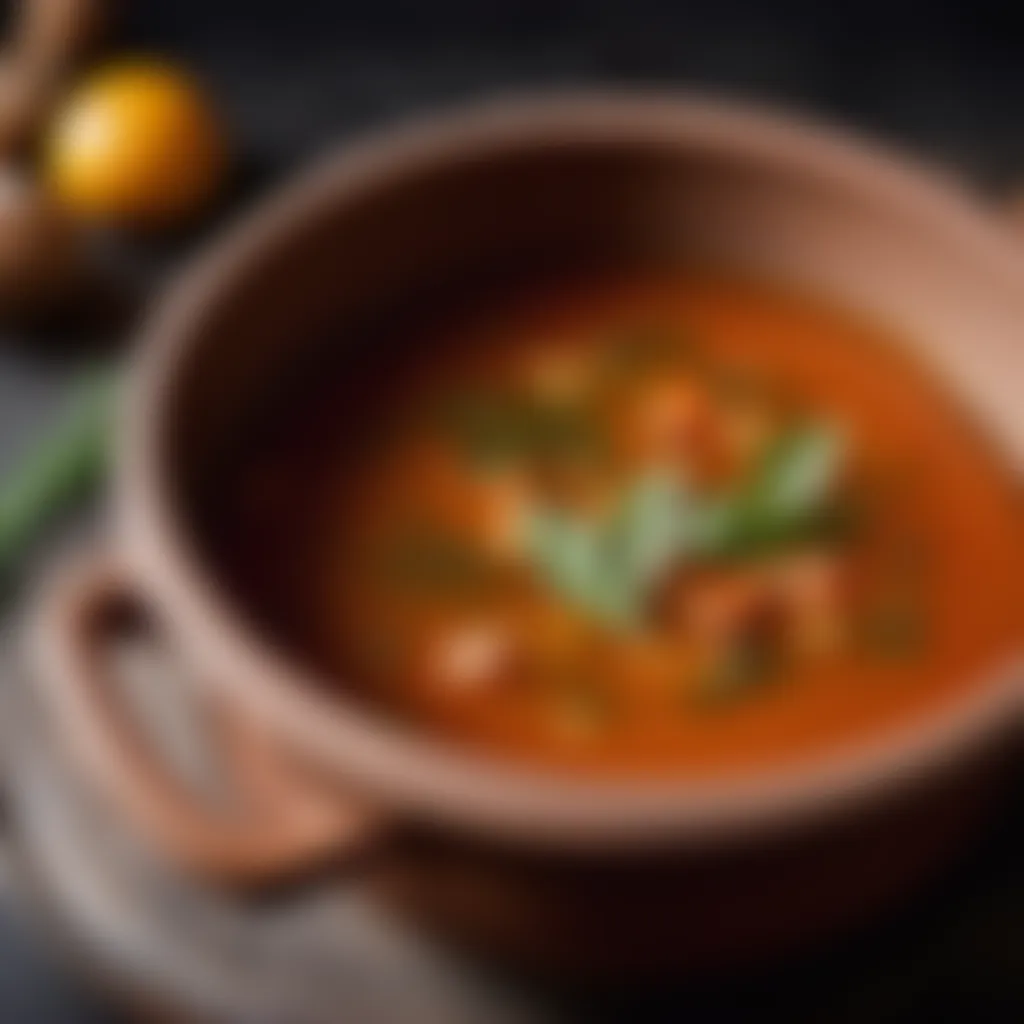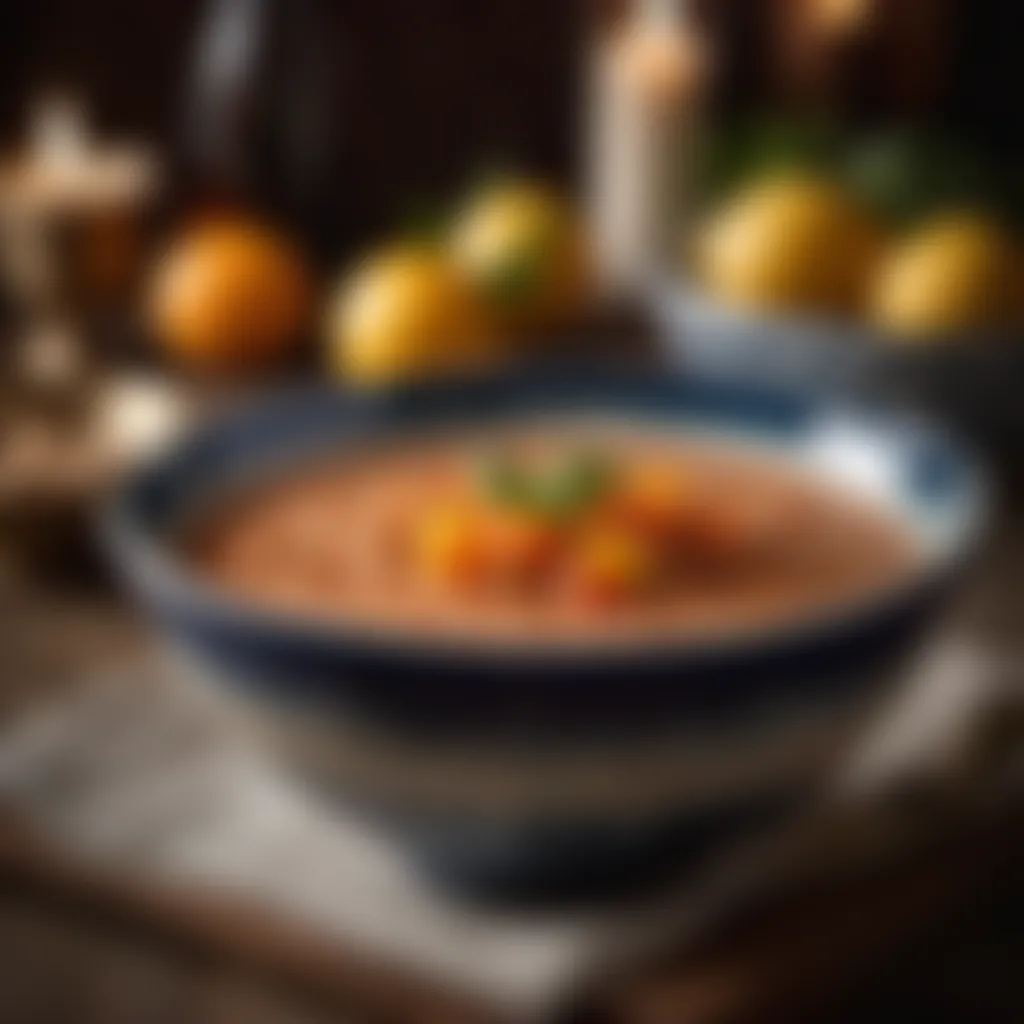Experience the Rich Flavors of Acquacotta Soup


Intro
When it comes to Italian cuisine, one might think of pasta, pizzas, or rich sauces, but alas, there's an unsung hero that deserves the spotlight: Acquacotta. Originating from the rustic kitchens of Tuscany, this soup is more than just a dish; it's a story simmered in tradition and history. Imagine a warm bowl brimming with diverse ingredients that have been lovingly prepared, tied together by a flavorful broth. In this guide, we will journey through the steps to create Acquacotta, celebrating its layers of flavor and cultural significance along the way. Let’s dive into the heart of this culinary treasure, where every spoonful tells a tale of the land and its people.
Ingredients:
To prepare this delightful soup, it's essential to gather all the necessary ingredients beforehand. Here's what you'll need to create a traditional Acquacotta:
- Extra Virgin Olive Oil: 4 tablespoons
- Onion: 1 medium, finely chopped
- Carrot: 1 medium, diced
- Celery: 1 stalk, diced
- Garlic: 3 cloves, minced
- Tomatoes: 3 medium, peeled and diced (or 1 can of tomatoes)
- Vegetable Broth: 4 cups
- Stale Bread: 4 slices, preferably Tuscan
- Eggs: 2 (optional)
- Salt: to taste
- Black Pepper: to taste
- Fresh Herbs (like parsley): 2 tablespoons, chopped
These ingredients are the building blocks of Acquacotta, each adding its unique flair to the flavor profile of the soup.
Detailed Instructions:
Now that you have everything set up, let’s move on to the preparation steps needed to create this splendid dish:
- Sauté the Base:
Heat the extra virgin olive oil in a large pot over medium heat. Add the chopped onion, carrot, and celery. Sauté them until they are soft, about 5-7 minutes. The aroma should fill your kitchen, telling a tale of warmth and welcome. - Add Garlic and Tomato:
Stir in the minced garlic and diced tomatoes. Cook for another 5 minutes, allowing the tomatoes to soften and infuse the mixture with their rich flavor. - Pour in the Broth:
Slowly add the vegetable broth, and bring the soup to a gentle boil. Let it simmer for about 15-20 minutes so that all the flavors meld beautifully. - Prepare the Bread:
While the soup is simmering, take the slices of stale bread and cut them into cubes. You can toast them lightly if you prefer a bit of crunch in your soup. - Finish with an Egg (Optional):
If you’re opting for eggs, crack them gently into the simmering soup one at a time. Ensure they poach to your liking, anywhere from 3 to 5 minutes. - Season and Serve:
Before serving, taste the soup and adjust salt and pepper as needed. Add in the fresh herbs to brighten everything up.
Technical Aspects:
- Temperature Settings:
Maintain a medium heat throughout the cooking process. Too high, and you risk burning your base; too low, and the flavors won’t develop as they should. - Timing Specifics:
Aim for around 25-30 minutes total for preparation and cooking. Timeliness is key here, as you want to savor the flavors at their peak. - Critical Techniques:
Make sure to sauté the vegetables until they are just soft—this is crucial for building layered flavors in Acquacotta. Stirring consistently prevents anything from sticking to the bottom.
Preface to Acquacotta
Acquacotta, a name that might roll off your tongue like a melody, is more than just a traditional Italian soup; it’s a culinary narrative steeped in history and culture. This section aims to present the essence of Acquacotta, not just as a dish, but as a reflection of the land and people from where it originates. Understanding this dish is essential for anyone looking to appreciate Italian cuisine fully. Each bowl cooked is a testament to the ingredients, the method, and the region it hails from.
The importance of Acquacotta in this article cannot be overstated. It serves as a vivid representation of the rustic culinary practices that have shaped Italian households for generations. By exploring its historical background and cultural relevance, readers will gain insights into the techniques and philosophies behind traditional cooking. This understanding enhances the cooking process, making it more than just a task; it becomes a revered art.
Historical Context
Diving into the roots of Acquacotta reveals a tapestry of stories. This traditional dish emerged from the kitchens of Tuscany, borne by the need of shepherds and farmers to create hearty sustenance from simple, available ingredients. In the 19th century, it was often made as a way to use up leftover vegetables and stale bread, highlighting the resourcefulness of those who prepared it. This aspect of thrifty cooking offers an appealing invitation for modern cooks to rethink how they use ingredients, advocating for respect towards what food provides.
"Acquacotta is not just a meal; it’s a way of honoring what the land yields."
Every spoonful you taste is rich with history, telling tales of pastoral life and communal gatherings. Acquacotta was not just nurtured through time in the kitchens but also passed along through stories told over dinner tables, fostering a sense of belonging and tradition among families. The soup became a staple not merely for satiation but for social connection, embodying the Italian spirit of community.
Cultural Significance
In Italian culture, food holds a pivotal role, serving as a medium for shared experiences. Acquacotta embodies this cultural significance. Festivals, family gatherings, and communal meals often feature this soup, making it a source of pride and a culinary symbol of togetherness. Its various adaptations across regions in Italy further underline its importance not only as sustenance but as a marker of cultural identity.
Acquacotta is also celebrated for its inclusivity. It can adapt to whatever ingredients are available, which means it can be made in countless ways, reflecting local tastes and traditions. This adaptability allows it to remain relevant across different generations, nourishing both bodies and bonds.
In summary, recognizing the historical and cultural significance of Acquacotta enriches one’s culinary experience. Understanding its context helps diners appreciate the deep connections that food can forge, making each meal a meaningful encounter, a delightful foray into Italy’s culinary soul.
Key Ingredients of Acquacotta


The heart of Acquacotta lies in its ingredients. Each element plays a vital role in forming the soup's distinctive flavor profile. Understanding these components helps not only in cooking but also in appreciating the tradition behind this ancient recipe. Let’s dive into the essentials that make Acquacotta a genuine gastronomic delight.
Vegetables and Their Role
At the core of Acquacotta’s delectable nature are the vegetables. These are not just fillers; they’re the essence of flavor and nutrition. Think of cabbage, carrots, celery, and zucchini—each contributes a unique texture and sweetness that shines through the broth.
- Cabbage adds a subtle crunch and absorbs the flavors beautifully.
- Carrots offer a natural sweetness and vibrant color, making the dish visually appealing.
- Celery provides a slightly peppery note that enhances the overall taste.
- Zucchini lends a delicate softness, creating harmony across stages of the cooking process.
As these vegetables simmer together, they release their juices, melding into a thick, rich amalgamation. This not only elevates the dish but also creates a comforting warmth that feels like a hug in a bowl.
Herbs and Seasoning
No dish is complete without the proper seasonings, and Acquacotta is no exception. The right herbs are like a maestro conducting an orchestra; they pull the flavors together to produce mouthwatering results.
Key herbs include sage, rosemary, and parsley. These aren’t just aromatic; they add layers of complexity.
- Sage has a slightly peppery and earth flavor that beautifully complements the vegetables.
- Rosemary brings a resinous warmth which is synonymous with Italian cuisine. Its robust nature shines brighter as the soup slowly cooks.
- Parsley adds a fresh brightness, a finishing touch that opens up the flavors right before serving.
The careful balance of these herbs can make or break your Acquacotta, so don’t skimp on fresh ingredients.
The Importance of Broth
The broth, my dears, is the crown jewel of Acquacotta. It’s what ties all the elements together. A well-made broth can transform a mediocre soup into a stellar dish. Traditionally, Acquacotta takes on a vegetable or meat-based broth, depending on the cook’s preference. Opting for homemade broth adds depth and richness that store-bought simply can’t replicate.
- Vegetable Broth: Provides a lighter, refreshing taste, allowing the vegetables to really stand out.
- Meat Broth: Adds a robust flavor, which some might find comforting on colder days.
When simmering, your broth should be seasoned with salt and pepper, giving it just the right kick. More than just a base, the broth should communicate flavors and warmth, ready to be soaked up by crusty bread or paired with a glass of wine.
The quality of your ingredients is crucial. Using the freshest vegetables and homemade broth ensures that your Acquacotta remains authentic, full of tradition, and absolutely irresistible.
Regional Variations of Acquacotta
Acquacotta, while rooted in the heart of Tuscany, has branches that reach into various regions of Italy. These regional variations are not just casual alterations; they speak volumes about the local culture, ingredients, and culinary preferences. Understanding these differences adds layers to the appreciation of Acquacotta as not merely a dish, but a canvas reflecting Italy's diverse gastronomic heritage.
The variations you encounter from one region to another offer a glimpse into the local climate and agricultural bounty. For example, in Tuscany, the simplicity of its ingredients echoes the frugality the region's past endured. Whereas in other Italian areas, the inclusion of different spices or meats may reveal an influence from neighboring traditions—often transforming a rustic dish into something entirely unique.
Importantly, these variations highlight how culinary practices can adapt and evolve over time. This adaptability is key to understanding how a traditional recipe can remain relevant across generations. With Acquacotta, it’s not only about a recipe; it’s about embodying the essence of where it comes from.
Tuscan Influences
Tuscany's unique topography and climate play a significant role in the flavor profile of its Acquacotta. Locals often embrace seasonal ingredients, showcasing what their land has to offer at any given time of year.
A classic Tuscan Acquacotta typically features vegetables like tomatoes, carrots, and celery, all sautéed in olive oil, which is a staple in Tuscan kitchens. The flavor is deepened by the use of homegrown herbs like rosemary and parsley, often creating a melody of flavors that resonate with the countryside.
The Tuscany region might include bread as a key component in their Acquacotta, adding texture and heartiness to the dish. Traditionally, stale bread is used, which gets softened by the broth, embodying that famous Tuscan frugality where nothing goes to waste. This local adaptation is a testament to the resourcefulness that characterizes Tuscan cooking.


Other Italian Regions
As you journey beyond Tuscany, the variations of Acquacotta become even more intriguing. Other regions in Italy have their own flavor twists, reflecting local ingredients and traditions. For instance, in Lazio, where Rome is located, the recipe may lean towards incorporating cicoria (a type of chicory) and pasta, creating a more substantial meal that warms you from the inside out.
In regions like Umbria and Marche, potatoes may take center stage. The creamy texture of potatoes combined with the broth creates a comforting embrace, whereas the addition of salsiccia (Italian sausage) can elevate the dish into a sumptuous delight fit for a feast. The interplay of flavors varies, but the essence of nourishment remains central across regions.
Here's a brief overview of the regional differences reflected in Acquacotta:
- Tuscany: Emphasis on seasonal vegetables, stale bread, and local herbs.
- Lazio: Includes chicory and sometimes pasta, creating a heartier soup.
- Umbria and Marche: Often features potatoes and sausage, bringing a richer depth.
The beauty of Acquacotta lies in its ability to adapt. Each region adds a personal touch, making it a dish that not only nourishes the body but also connects the eater with the land and the locals who have perfected their own version through generations.
Preparation Techniques
The preparation methods behind Acquacotta are the secret sauce that truly bring this traditional Italian dish to life. They can make or break the culinary experience, ensuring that every bowl served yields not just a meal but a rich tapestry of flavor and history. With Acquacotta, the journey starts from selecting the right ingredients and moves through each technique to the final act of serving. Understanding these preparation techniques is crucial in achieving that authentic taste.
Traditional Cooking Methods
When talking about traditional cooking methods for Acquacotta, we enter a world where practice meets passion. Originally born in the rural kitchens of Tuscany, the techniques used have been passed down through generations. Here’s how that unfolds:
- Slow Cooking: One of the cornerstones of Acquacotta's charm is patience. The broth is typically made by simmering various vegetables and herbs for hours. This approach draws out the sweetness of onions, the earthiness of carrots, and the zest of tomatoes, creating a deep and complex flavor profile.
- Layering Flavors: A common method involves layering flavors. Start with a base of sautéed onions and garlic in olive oil, followed by the addition of hardy vegetables. This layered technique captures each essence, ensuring that no ingredient’s flavor is overpowered.
- Hand-Crafted Elements: Many traditional recipes call for using simple tools like wooden spoons and clay pots. These elements not only influence the cooking process but can also impart a unique taste, as clay pots retain heat well and promote even cooking.
Each of these methods is a celebration of not just the ingredients but the culture and stories behind them. The beauty lies in treating the ingredients with respect, allowing them to shine.
Modern Adaptations
In today�’s fast-paced kitchen environment, modern adaptations of Acquacotta recipes have emerged, keeping the spirit of the dish alive while catering to contemporary tastes and lifestyles. Here’s a look at some of those adaptations:
- Speed Cooking: With advancements in technology, pressure cookers can replicate the slow-cooked flavors of traditional Acquacotta in a fraction of the time. This method does not compromise quality; instead, it offers the same deep flavors with a quicker turnaround, perfect for busy weeknights.
- Fusion Ingredients: Modern takes often incorporate diverse ingredients. From adding quinoa for a protein boost to experimenting with different chiles for a kick, the possibilities are endless. This fusion opens up the dish to a broader audience, making it relatable while still respecting its roots.
- Customized Broths: Instead of the traditional vegetable broth, many home cooks opt for more robust bases, like a homemade chicken or beef broth. These broths can elevate the dish to new heights, appealing to varied palates while ensuring the rich essence of Acquacotta remains intact.
In summation, both traditional methods and modern adaptations each play vital roles in the preparation of Acquacotta. Understanding and mastering these techniques allow for creativity while preserving the foundational heritage of this beloved dish. Acquacotta is not just a recipe; it’s a canvas for culinary expression.
Pairing Acquacotta
Pairing Acquacotta is more than just serving a dish alongside a drink; it’s about matching flavors and enhancing the overall experience of this rich Italian soup. To truly indulge in the experience, attention must be paid to the elements at play—the aromatic herbs, the hearty vegetables, and the savory broth. Each of these components carries its own narrative, and the right accompaniment lifts the entire meal to new heights. Here’s a dive into how to harmonize your Acquacotta with suitable wine and complementary dishes.
Wine Recommendations
When it comes to wine, not all are made equal. Acquacotta’s earthy and rustic character calls for wines that can either contrast its robust nature or compliment it seamlessly.
- Chianti: This classic red wine from Tuscany is a stellar partner to Acquacotta. Its bright acidity and berry notes harmonize beautifully with the rich flavors of the soup, creating a delightful balance on the palate.
- Vermentino: If you prefer white wine, consider Vermentino. This lively white offers a citrusy twist that can refresh your palate, especially if your Acquacotta leans heavily on tomato base. Its minerality closely mimics that of the broth, tying the meal nicely.
- Morellino di Scansano: This wine brings together a blend that echoes the essence of Acquacotta. With its tannins providing just enough grip, it supports the soup’s ingredients while allowing the spices to shine through.
Pairing your soup with a glass of one of these wines highlights the depth of flavors in both the Acquacotta and the drink, making each sip more satisfying.
Complementary Dishes


Acquacotta is delicious on its own, but certain dishes can further enhance this meal, creating a heartier culinary affair.
- Bruschetta: A starter of toasted bread topped with fresh tomatoes, basil, and a drizzle of olive oil perfectly prepares the taste buds for what’s to come. Its crunch and freshness set the stage nicely.
- Caciotta Cheese: Offering a creamy texture and mild flavor, this cheese can be served alongside. Its richness complements the soup without overpowering it; a perfect pairing.
- Green Salad: A light, leafy salad dressed simply with olive oil and vinegar cuts through the richness of the soup. Toss in some nuts or seeds for added crunch.
- Grilled Vegetables: Grilled seasonal vegetables also harmonize well, bringing a smoky element to the table that matches well with the flavors in Acquacotta.
Each of these dishes adds its own flavor profile and texture, creating a layered dining experience that embraces the essence of Italian cuisine.
The right pairing can elevate a simple meal into a memorable feast, enhancing not just the food but the very act of sharing it with loved ones.
Nutritional Aspects of Acquacotta
Understanding the nutritional components of Acquacotta goes beyond merely counting calories. This traditional soup provides a delightful amalgamation of flavors that not only tantalizes the taste buds but also offers nutritional benefits associated with a well-rounded diet. It can serve as an wholesome meal option, bursting with vitamins, minerals, and fiber, essential for maintaining overall health.
Health Benefits of Key Ingredients
When we peel back the layers of Acquacotta, we discover a treasure trove of ingredients that contribute to its healthful profile. Each component plays a vital role:
- Vegetables: Root vegetables like carrots and potatoes bring in beta-carotene and potassium. They can aid in maintaining heart health and stable blood pressure.
- Leafy Greens: Common in many versions of this soup, greens add iron and vitamin K, essential for bone health. Ingredients like kale or spinach elevate the nutritional density, fortifying the soup further.
- Legumes: Ingredients such as beans not only boost the protein content but also provide essential fibers that help in digestion and can keep you feeling full for longer.
- Olive Oil: Often used in the preparation, olive oil is packed with monounsaturated fats that are beneficial for heart health. It often comes along with antioxidants, aiding in reducing inflammation.
"A single bowl of Acquacotta not only soothes hunger but also nourishes your body with nature's bounty."
These ingredients make Acquacotta more than just comforting; they transform it into a nourishing dish that can easily fit into any healthy eating plan.
Caloric Content and Serving Sizes
When dishing out Acquacotta, understanding portion sizes is key for those keeping an eye on their caloric intake. A standard serving of Acquacotta typically ranges from 250 to 350 calories, largely dictated by the ingredients used. Here's what to consider:
- Base Serving Size: A cup of the soup can serve as an ideal starter or a light meal on its own. This basic serving provides a satisfying yet low-calorie option.
- Customizations: Adding proteins or extra vegetables will impact the caloric content significantly. For instance, adding a dollop of ricotta or a slice of hearty bread can push it upwards of 450 calories.
- Balancing the Plate: Pairing Acquacotta with a crisp salad can help ensure a fulfilling meal without excessive calorie counts. The key is moderation, and being aware of additional toppings and sides will help in maintaining a balanced meal.
While the recipe can be altered to suit dietary preferences, keeping track of portion sizes ensures that Acquacotta remains indulgent yet mindful, allowing its lovers to enjoy its flavors without worry.
Ending and Final Thoughts
When one thinks about food, especially in the context of a country's culinary traditions, it’s often the stories and experiences tied to these meals that leave a lasting impression. In this journey through Acquacotta, we've uncovered a dish that's much more than mere sustenance; it's a tapestry of historical depth and cultural significance intertwined with the vibrant colors of Italy's landscapes. The act of cooking and sharing Acquacotta serves not just to nourish the body but also to invigorate the spirit, a ritual to connect generations.
Why You Should Try Acquacotta
So, what makes Acquacotta stand out in the crowded buffet of culinary pleasures? First off, it's a unique blend of flavors. The earthiness of the vegetables combined with the richness of the broth creates a harmony that's hard to beat. Imagine sitting down with family or friends, serving up bowls of hot Acquacotta, the aroma wafting through the air, drawing everyone to the table.
- Health Benefits: The core ingredients aren’t just tasty; they’re nourishing. Packed with vitamins and minerals, this dish can fit beautifully into a balanced diet. Spinach, tomatoes, and beans bring a wealth of benefits, supporting overall health.
- Versatility: This dish can easily adapt to suit personal preferences or dietary restrictions. Whether you prefer it vegetarian or want to add some meat, Acquacotta is your faithful companion in the kitchen, easy to tailor to your tastes.
- Culinary Adventure: Cooking Acquacotta is seeing a slice of history and a journey into Italian traditions unfold. It encourages experimentation while respecting the origins of the dish.
Reflecting on Italian Culinary Heritage
Acquacotta isn't merely about the ingredients or the method of preparation; it’s about the stories behind its existence. This dish has roots in the humble kitchens of Italy, where resourcefulness reigned. During times of scarcity, this soup was a way to transform simple vegetables and day-old bread into something heartwarming and nourishing.
In every ladle of Acquacotta, you savor centuries of tradition. Its significance reminds us that food reflects the region’s environment and economy at any given time. The incorporation of local ingredients demonstrates a deep understanding of seasonal produce and how to leverage what’s available.
Moreover, by savoring Acquacotta, you partake in a cultural heritage that emphasizes familial bonds and community. Cooking together, sharing stories over bubbling broth, is a beloved ritual that transcends time. It teaches us to appreciate simplicity and taste the love and stories wrapped up in every bowl.
"Food is a central activity of mankind and one of the single most significant trademarks of a culture." – Peter Farb
As you take this culinary trip with Acquacotta, remember it’s not just about following a recipe. It’s about embracing a slice of Italian life and raising your spoon to toast its rich history.







